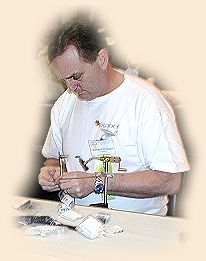|
I did some popper experiments last summer. I
have been making my own poppers for a long time.
I got a set of punches a year ago and have been
using them to make different size circles of the
closed cell foam sheets that can be purchased at
many stores. This way I can make the colors and
sizes that I want to use.
I cut the circles out by using the punch against
a board. I cut out several circles of each color
of foam that I am going to use and then go back
to glue them. I use rubber cement to keep them
together. This has worked well for me and the popper
does not come apart. They stay softer than using
super glue. I use one of the cheap artists paint
brushes to spread the rubber cement on the foam.
I do it on the sides of the two disks that are
going to be put together. I let it dry for a little
while, until it gets tacky and then put the two
pieces together. When I have a bunch of these done,
I then put them under a board that I have and put
some weight on it. The next time I add one more disc
to each stack that I want to have five disks on. If
I want six disks then I put another disc of foam on
each of the two that had I glued together before. For
a 5-disk popper I then put a stack of two and a stack
of three foam disks together. For a 6-disk popper it
is two stacks of three put together. I have found by
doing this that I can keep the edges of the foam circles
pretty even. This does take a little more time, but it
is easier than sanding.
I took out poppers that I made this way and poppers
that I cut one size larger and then sanded down,
with a Dremel tool, to the same size. These sanded
poppers were very smooth. I would cast out two
poppers about four to five feet apart. Each time
the poppers were the same color combination and
the same size. I would also alternate which side
I cast the smooth popper on with the side of the
rougher popper.
From my very rough notes of last summer I cannot
tell a difference in the number of fish that I
caught on each. I caught as many fish on the
poppers that I left the edges slightly uneven
as the poppers that were sanded smooth. I have
these in sizes for panfish and for bass. The
numbers just don't show a difference.
To take it a step farther, for someone who is
obsessive compulsive at times to see what may
work, I also used cylinders of foam that had to
be cut to length. I made poppers from these that
were smooth. I also took some that I used various
Dremel tools to score different patterns of grooves
around the foam. This would make them like the disks
of foam that were not even.
The number of fish that I caught on these different
poppers was very nearly the same for each type. These
were the size to catch panfish on, even though I did
get a fair number of bass to hit them.
My take from this is that we may worry too much
about having the popper look perfect. It might be
that with the edges a little uneven that the popper
looks like it has been hurt or damaged and thus
is more vulnerable that a popper than is smooth.
The meniscus that these make when you put them
in a glass of water and look at them from the
bottom is different from the meniscus made by
a smooth popper.
I got on to doing this after I got the book
Tying Flies the Paraloop Way. This
book has pictures of flies taken underwater to show
the differences in the way they sat on the water and
in the meniscus that was formed. My setup might not
be as pretty or elaborate but I can see differences
when I look through the bottom of that clear glass.
For example, take a normal Adams and a Parachute
Adams and put them in the glass as the same time.
I think you will be able to see a difference in
the way they set on the water.
Each time I tie a new pattern I try it this way
just to see how it sets on the water and looks
to my non-fish eyes. It does help you decide if
you want to make any changes and after a while
if the meniscus looks like the ones formed by
other patterns that work for you.
Something else that I have done behind poppers
is to tie a dropper fly about 12 to 24 inches
behind it. I use Pheasant Tail Nymphs, midges,
and other flies in the size 16 to 20 range. I
find that many times I will catch fish on the
dropper when they will not hit the popper but
will come up to look at it. Fairly often
after a fish hits the dropper and with it jerking
the popper around, another fish will hit the popper.
Let me know if you agree or think that I am nuts.
Hope you can get out on the water. ~ Rick
ziegeria@grm.net
|



